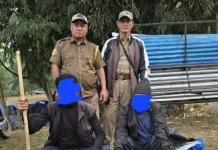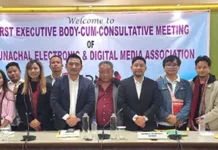[ Ranju Dodum ]
Pioneer, brave, pathfinder, entertaining – these are just some of the adjectives that will be thrown around in the next few days as people pour in their messages of condolences for the late Taro Chatung.
Clichéd as they may be, all these words aptly describe the man who left this world too soon.
In the early ’90s, when even seeking a job out of the traditional lines was seen as an anathema in Arunachal Pradesh, Taro Chatung did the unthinkable by voluntarily resigning from his plush state government job to pursue a career in journalism; a thankless job if there ever was one.
However, his love affair with the camera first began with films. Inspired by ’80s and ’90s action movies of Hong Kong, with influences of Bollywood storylines, Taro Chatung’s films carved a niche for Arunachal cinema in a way that had never existed, and perhaps the kind of space that will never be replicated.
After all, Frontier Student may not be a cinematic masterpiece that will ever be screened at the Cannes, but when you have a Taro Chatung film, it doesn’t have to.
From being behind the camera, Taro Chatung moved to the front, bringing to viewers of Doordarshan a kind of viewing experience that people of the state had never witnessed before (or since).
When the evening set in, families gathered in front of their television sets to watch on grainy screens Chatung go on his quest for answers to questions that they only asked in hushed tones in the confines of their home walls. Armed with a cameraman and his unique style of questioning, Chatung made us stand up and take notice – all the while ensuring that we received our daily dose of entertainment with our information.
News & Views, like its creator, was a trailblazer; its impact something that the present generation of journalists can only hope to emulate.
Not only did the show inform its viewers about the latest happenings around us, it gave us some of the most epic and memorable moments caught on camera. His memorable questions, which would often leave the interviewee befuddled, are too many to list in one sitting.
While his unique sense of interviewing won him many fans, it didn’t help him win friends as the high and the mighty are often overtly sensitive and not used to being held accountable.
As time went by, under the financial pressures of running an electronic news outlet that generates little to no revenue (even today), he went off the radar for some time, but only to return after a brief hiatus with a major bang.
As in the movies, Taro Chatung’s new avatar was leaner and meaner. Stripped off a bulky camera and additional staff, donning his signature fedora hat, Chatung shoved his DSLR into the faces of unsuspecting subjects of his hard-hitting questions.
The way he conducted his interviews in the final years of his life was almost voyeuristic in nature, with the person asking the questions only heard but not seen. But the questions he asked were distinctly his; the flair, the line of questioning, that distinct voice, were signature Taro Chatung.
One of his last works exposed the hypocrisy of politics and angered many politicians. It’s a shame that some even took to blaming him for essentially doing his job: asking politicians their opinions on a subject that affects each and every citizen of the state.
Yet, as news of his failing health began doing the rounds, the number of people who came to visit him at the hospital was only testimony to the love and respect that he commanded. And the number of condolence messages that have poured in only seal his reputation.
At the end of the day, his passing has left a void that can never be filled. We are poorer today because of his untimely death. Perhaps he is asking us all from beyond the grave his trademark question: Aap ko kesa lag raha hain?
To that we say, sir, bohot bura.
Rest in peace.




